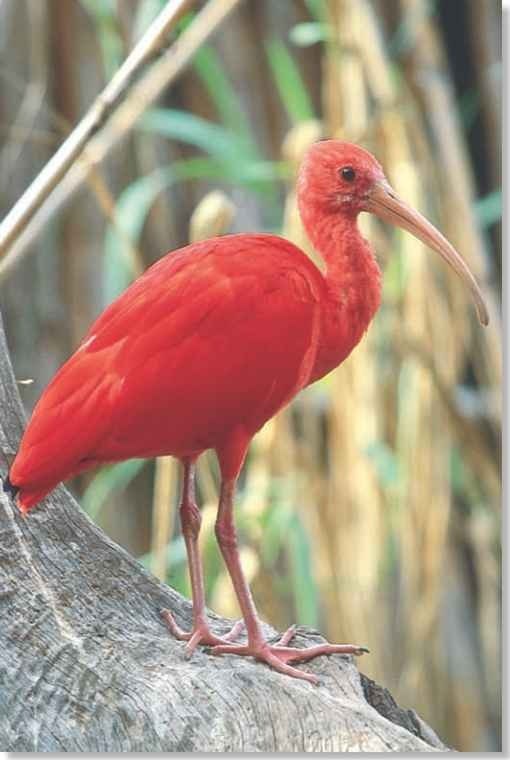ORDER
Ciconiiformes
FAMILY
Threskiornithidae
GENUS & SPECIES
KEY FEATURES
• One of the most spectacular wading birds, displaying white or scarlet plumage
• The ibis can fly in excess of 25 mph while soaring to great heights
• Males and females have identical plumage, but the male is much larger and has a longer
bill
• Legs, face and bill change colors during courtship
WHERE IN THE WORLD?
Found over the coastal plains of southeastern North America through Central America and the Greater Antilles; also in South America in Brazil, throughout the plains of Colombia and Venezuela
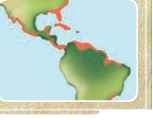
Lifecycle
The nomadic scarlet ibis feeds in flocks, relying on changing tides to reveal its food sources, but this social bird can be aggressive when defending its breeding territory.
Habitat
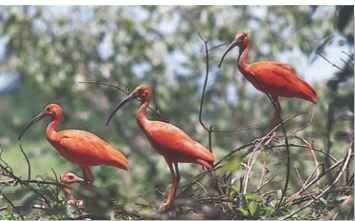
A Colonial roost Three ibises have prime perches on a coastal bush.
The scarlet ibis adapts to an array of coastal locations. Birds may be spotted in open marine lagoons, exposed tidal flats,
gardens, residential yards, ball fields, golf courses, agricultural fields, garbage dumps and even the rice fields in the treeless plains (llanos). In North America, the bird nests as far north as Virginia and south through Florida to Louisiana; it also nests along the coasts of Mexico, Belize and Nicaragua. In South America, populations occur in the interior of Columbia and along the Atlantic coast from Guyana to Brazil. Though both white and red scarlet ibises can be found in North and South America, there tend to be more white individuals in the north and more red in the south.
A tourist industry has developed in the Caroni Swamp of Trinidad where people observe the scarlet ibises flocking to their night roost.
In Louisiana, 64% of all nests were lost during incubation because of high tides.
Breeding
Breeding colonies are large, dense and almost always located above some type of water, usually islands, mangrove swamps or gallery forests. Males arrive first to establish roosting sites; they participatein numerous displays, including shaking, flying, head-rubbing and bill- popping — snapping the bill shut with a quiet pop. But the courtship ritual can become violent: females often walk away bloodied, since the male is so aggressive in defending his individual space at the site. Females select and build the nests; the males provide sticks and other building materials. Nests are closely grouped in trees or on the ground; both parents guard the 2-5 cream to blue-green eggs. After about 21 days, the chicks hatch, and the newborn birds are completely dependent on their parents for food. The chicks’ legs develop within two weeks, but they do not leave the nest completely until they are about 50 days old.
Behavior
Though it is a gregarious bird, the scarlet ibis can become highly aggressive during territorial defense. Larger males usually win contests for food or space; fights may occur between males of the same or different bird species.The scarlet ibis flies by alternating rapid wing beats and gliding, usually in a V-formation; flight speeds often exceed 25 mph. Aerobatics are part of displays, where bachelors try to impress females, but are also part of the bird’s regular feeding and roosting habits. For example, the bird often soars to great heights, then drops into a freefall before landing to roost. The bird’s primary call is a honk coupled with a squealing sound during courtship.
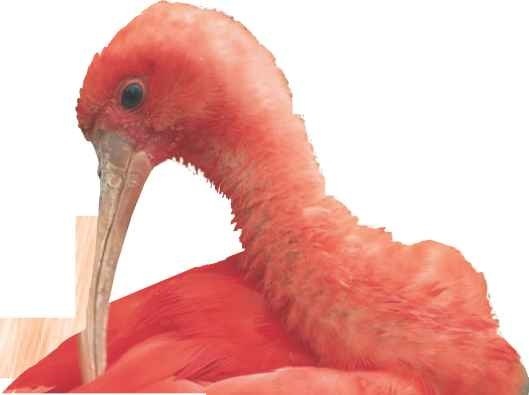
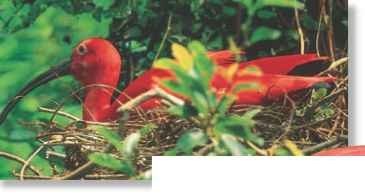
A Two-thirds done Two weeks of incubation completed; one more to go.
go with the flow
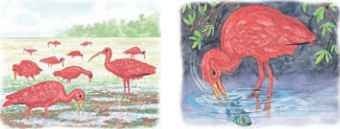
Communal feeding…
During low tide, a large flock of scarlet ibises use their long, thin bills to probe through a mud flat near a mangrove.
Tide begins to rise…
As the tide rises, and water floods the feeding grounds, the birds begin pursuing small fish that are visible on the water’s surface.
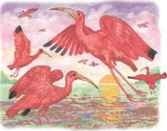
Night is falling…
As the sun sets, the flock sets out together for a journey of several miles back to the colonial roosting site.
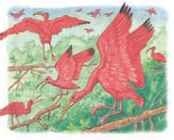
Home sweet home
The large flock descends into a mangrove forest, where the birds begin to jockey for prime roosting spots.
Food & feeding
This abundant species feeds in large groups and frequents saltwater, but it can be found at freshwater locales as well. The scarlet ibis glides into a feeding site and uses its long bill to probe for food in shallow water, where it finds small fish, crustaceans, aquatic insects, worms, snails and fiddler crabs. Small prey is consumed immediately, while larger morsels are broken into bite-sized pieces. The bird will take flight if disturbed, sometimes performing aerial maneuvers until it is safe to return. Juveniles flock and feed separately from adults during the first and second years.
A probing profile
A juvenile wades, lifting vegetation in its search for aquatic food.
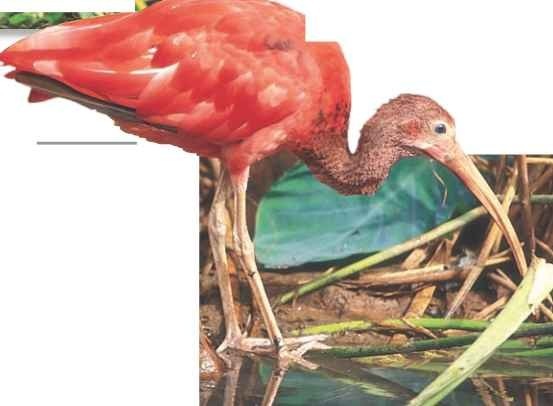
conservation
In many regions, scarlet ibis populations remain high. However, decreased numbers have been reported in the Florida Everglades and also areas of South America, where the bird is hunted for its feathers.The scarlet ibis is on the endangered species list in Brazil. In French Guiana, the bird’s feathers are used to manufacture artificial flowers.Though hunting restrictions are in place in South America, they are rarely enforced. The United States government is making an effort to preserve the wetland habitats of the bird.
Profile
Scarlet Ibis
Soaring scarlet ibis flocks are one of the great spectacles of nature; during mating, color changes in both sexes heighten the colorful display.
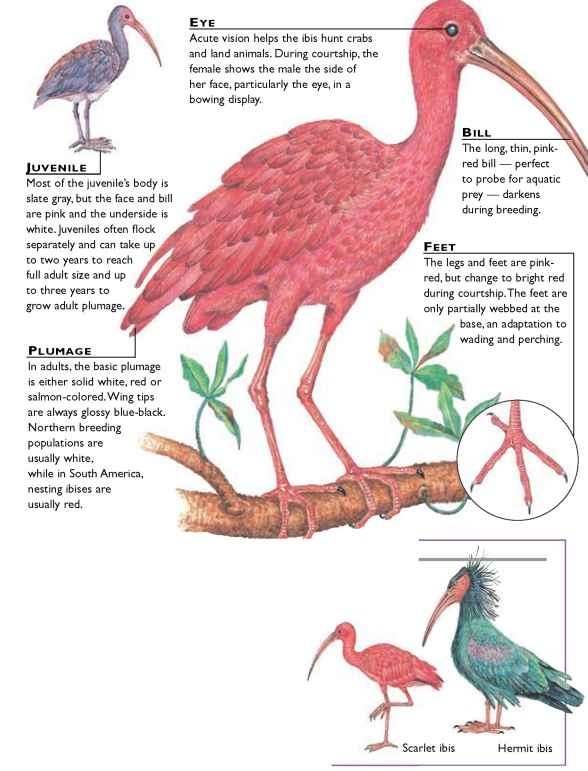
Creature comparisons
Measuring up to 31.5″ in length, the hermit ibis (Geronticus eremita), also known as the waldrapp ibis, is darker and larger than the scarlet ibis. Its bare, red head is covered by a ruff of feathers, which give the bird an unkempt appearance. The base plumage of the hermit ibis is dark metallic green tinged with purple, a sharp contrast to the white or red of the scarlet ibis. Unlike its aquatic cousin, the hermit ibis is mostly terrestrial and can be found in the rr of Europe, Africa and into the Middle East.
| VITAL | |
| STATISTICS | |
| Weight | About 30 oz. |
| Length | 23-27″; males larger than females |
| Wingspan | 38″ |
| Sexual ‘Maturity | 3 years |
| Breeding Season | March-September |
| Number of Eggs | 2-5 |
| Incubation 21 days Period | |
| Fledging Period | 50 days |
| Breeding Interval | Usually 1 year |
| Typical Diet | Crayfish, snails, insects and fish |
| Lifespan | Unknown in wild; 7.5 years in captivity |
RELATED SPECIES
• The scarlet ibis is one of about 33 species of ibis and spoonbill in the family Threskiornithidae. .Its relatives include the glossy ibis, Plegadis falcinellus, white-faced ibis, P. chihi, roseate spoonbill, Ajaia ajaja, and white spoonbill, Platalea leucorodia, which are all found in North America. The other species are found in Africa, Eurasia, Central and South America and Australia.
